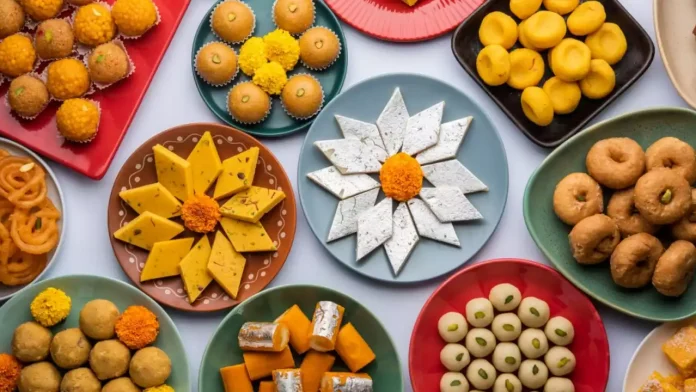As India approaches the festive season, the Mithai and Namkeen industry is brimming with optimism. Firoz H. Naqvi, Founder and Director General of the Federation of Sweets and Namkeen Manufacturers, sees a bright future for the sector, driven by innovation, branding, and evolving consumer preferences.
Growth in Festive Season
With the festive season in full swing, Naqvi is confident that the Mithai and Namkeen industry is on the cusp of significant growth. “The next six months are going to be extremely busy for us, with Raksha Bandhan, Janmashtami, Navratri, Diwali, and the wedding season following immediately after,” he shares.
He expects festive season to drive record sales, and with ongoing innovations in the industry, the Mithai and Namkeen sector is poised for exponential growth in the coming years.
According to him, currently, this market is valued at INR 1.25 lakh crore, with a projected growth rate of 12% to 15% annually. Namkeen dominates this market, accounting for INR 55,000 to INR 60,000 crore, while Mithai still largely operates in the unorganized sector, with only 7% to 8% of branded Mithai companies.
“Majority sold loose, especially in smaller towns. But branded sweets are growing at a rate of over 40% to 50% annually, and this trend is only expected to accelerate,” says Naqvi.
Naqvi then discusses how numerous trends have transformed India’s sweet and savory snack market.
Post-Pandemic Revival
Naqvi reflects on how the pandemic drastically reshaped the industry. “COVID proved that Mithai, traditionally sold loose and unbranded with minimal shelf life, was out of demand. In contrast, snack foods and namkeen, with longer shelf life and automatic packaging, saw skyrocketing sales,” he explains. The crisis acted as a catalyst, pushing the industry to prioritize branding, packaging, and product longevity.
This shift has led to an industry boom, with new brands entering the market and established players like Haldiram’s and Lal Sweets expanding aggressively. “Today, we have more than 100 brands in the industry,” Naqvi adds, highlighting how branding and innovation have become essential drivers of growth.
Fusion and Culinary Innovation
India’s diversity in food culture has also played a pivotal role in the expansion of the market. Naqvi emphasizes that the industry is capitalizing on this by introducing fusion sweets, blending traditional flavors with international twists. “New generation consumers are adapting to different ways of making sweets, like Ladoos and Burfis with Italian or American flavors,” he notes.
With over 400 to 500 types of sweets in India, the potential for creativity and expansion is enormous. “Our diversity is our biggest strength. We are creating sweets that appeal to different palates globally,” says Naqvi.
Continue Exploring: 82% of Indians prefer traditional sweets over other desserts, survey finds
Tier 2 Cities Lead the Charge
Interestingly, the market growth is not just limited to metro cities. According to Naqvi, tier 2 cities and smaller towns are witnessing higher demand than urban centers. “Disposable incomes have increased drastically in tier 2 cities. If we compare Pune’s sweet consumption with Mumbai’s, Pune is higher. Surat surpasses Pune, and Jaipur even exceeds Surat,” he explains. This surge is driven by cultural preferences, with sweets being an integral part of celebrations in smaller cities.
Regional preferences also play a critical role in shaping the market. Naqvi mentions that North and East India are significant consumers of sweets, with cultural habits deeply rooted in these regions. “In North India, sweets are a staple, and the tradition of consuming sweets is pushing the growth in these areas,” he adds.
Export Market
The players in this market have also begun to make strides in the export sector. Brands like Haldiram’s are expanding internationally, opening outlets in the UAE, Bikanevala is already doing good in UAE, A2B and Pista House in the US and many more are exploring new markets. “Exports are doing well, but it’s just the tip of the iceberg. The potential is enormous, especially if the government supports the industry in negotiating international trade agreements,” said Naqvi.
However, Naqvi cautions that exporting Indian sweets, especially milk-based products, remains a challenge due to strict international regulations. “It all depends on how our government helps us negotiate export terms. With the right support, Indian sweets can dominate global markets,” he adds.
GST Challenges
Another significant hurdle that the industry faces is the complexity of GST structure. Naqvi highlights the confusion and inconsistency in GST rates applied to different products. “There’s a lot of confusion around GST. For instance, loose namkeen is taxed at 5%, sweets at 5%, while branded namkeen is taxed at 12%. Similarly, bakery products have an 18% GST rate and so on,” he explains.
“On some sales we get input and in some cases we don’t get the input. The Federation has been advocating for streamlined GST regulations and clearer guidelines from the government. The industry needs a system that allows us to follow one clear formula without ambiguity,” says Naqvi.





